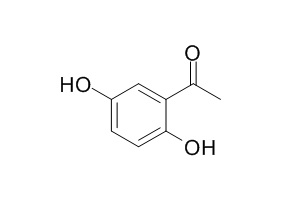2,5-Dihydroxyacetophenone
2,5-Dihydroxyacetophenone is an uncompetitive inhibitor of murine tyrosinase (K(I) 0.28mm), it strongly inhibits both melanogenesis and cellular tyrosinase activity, it possesses anti-inflammatoryanti-anxiety, and neuroprotective qualities. 2,5-Dihydroxyacetophenone treatment can induce a sustained activation of JNK, ERK1/2, and p38 MAPKs, it also can potentiate the pro-apoptotic and anti-proliferative effects of bortezomib in U266 cells.
Inquire / Order:
manager@chemfaces.com
Technical Inquiries:
service@chemfaces.com
Tel:
+86-27-84237783
Fax:
+86-27-84254680
Address:
1 Building, No. 83, CheCheng Rd., Wuhan Economic and Technological Development Zone, Wuhan, Hubei 430056, PRC
Providing storage is as stated on the product vial and the vial is kept tightly sealed, the product can be stored for up to
24 months(2-8C).
Wherever possible, you should prepare and use solutions on the same day. However, if you need to make up stock solutions in advance, we recommend that you store the solution as aliquots in tightly sealed vials at -20C. Generally, these will be useable for up to two weeks. Before use, and prior to opening the vial we recommend that you allow your product to equilibrate to room temperature for at least 1 hour.
Need more advice on solubility, usage and handling? Please email to: service@chemfaces.com
The packaging of the product may have turned upside down during transportation, resulting in the natural compounds adhering to the neck or cap of the vial. take the vial out of its packaging and gently shake to let the compounds fall to the bottom of the vial. for liquid products, centrifuge at 200-500 RPM to gather the liquid at the bottom of the vial. try to avoid loss or contamination during handling.
J Chromatogr B Analyt Technol Biomed Life Sci.2022, 1203:123307.
Anal Bioanal Chem.2016, 408(1):177-90.
Molecules. 2013, 18(7):7376-88
Sci Rep. 2018, 10590
J of the Society of Cosmetic Scientists of Korea2018, 44(4):407-417
Industrial Crops and Products2024, 129:119014
Phytother Res.2018, 32(5):923-932
Revista Brasileira de Farmacognosia2024, 34:1276-1286.
Braz J Biol.2023, 82:e266573.
Molecules.2019, 24(11):E2044
Related and Featured Products
J Med Food. 2012 Jun;15(6):505-10.
2,5-dihydroxyacetophenone isolated from Rehmanniae Radix Preparata inhibits inflammatory responses in lipopolysaccharide-stimulated RAW264.7 macrophages.[Pubmed:
22510152 ]
Rehmanniae Radix Preparata, the steamed root of Rehmannia glutinosa Libosch, has been widely used for the treatment of inflammatory conditions in Oriental medicines.
METHODS AND RESULTS:
In this study we evaluated the effects of 2,5-Dihydroxyacetophenone (DHAP) isolated from Rehmanniae Radix Preparata on inflammatory responses in lipopolysaccharide (LPS)-stimulated RAW264.7 mouse macrophages. LPS-stimulated RAW264.7 cells were used to investigate the anti-inflammatory activity of DHAP on the production of inflammatory mediators such as nitric oxide (NO), inducible NO synthase (iNOS), tumor necrosis factor-α (TNF-α), and interleukin (IL)-6. DHAP significantly inhibited NO production via the suppression of iNOS expression and significantly decreased levels of the pro-inflammatory cytokines TNF-α and IL-6 via the down-regulation of their mRNA expression in LPS-stimulated RAW264.7 cells. DHAP potently inhibited the phosphorylation of extracellular signal-related kinase (ERK) 1/2 and the nuclear translocation of nuclear factor-κB (NF-κB) p65 in LPS-stimulated cells. These results indicate that DHAP inhibits the production of inflammatory mediators in activated macrophages by blocking the ERK1/2 and NF-κB signaling pathways.
CONCLUSIONS:
Our results suggest that DHAP from Rehmanniae Radix Preparata has anti-inflammatory activity in activated macrophages, raising the possibility that this compound has a therapeutic potential for inflammatory conditions.
Exp Dermatol. 2011 Sep;20(9):720-4.
Murine tyrosinase inhibitors from Cynanchum bungei and evaluation of in vitro and in vivo depigmenting activity.[Pubmed:
21615508]
METHODS AND RESULTS:
Two natural acetophenone derivatives, 2,5-Dihydroxyacetophenone (2,5-DHAP) and 2,6-DHAP, were purified from Cynanchum bungei and identified as murine tyrosinase inhibitors. Investigation into 2,5-DHAP showed it to be an uncompetitive inhibitor of murine tyrosinase (K(I) 0.28 mm). 2,5-DHAP strongly inhibited both melanogenesis and cellular tyrosinase activity in vitro in 3-isobutyl-1-methylxanthin-stimulated B16 mouse melanoma cells or in vivo in zebrafish and mouse models, but showed no cytotoxicity at the concentrations used. In B16 cells, 2,5-DHAP inhibition was dose-dependent and was fourfold greater than that of arbutin. 2,5-DHAP had no effect on the expression of tyrosinase protein or mRNA, as confirmed by Western blotting and quantitative real-time reverse transcription polymerase chain reaction, respectively.
CONCLUSIONS:
A 2% gel preparation of 2,5-DHAP applied to the skin of mice significantly increased the average skin-whitening index (L value), indicating its potential use as a treatment for skin hyperpigmentation in humans.
Molecules. 2017 Jul 11;22(7).
2,5-Dihydroxyacetophenone Induces Apoptosis of Multiple Myeloma Cells by Regulating the MAPK Activation Pathway.[Pubmed:
28696369 ]
2,5-Dihydroxyacetophenone (DHAP) is an active compound obtained from Radix rehmanniae preparata, which is widely used as a herbal medicine in many Asian countries. DHAP has been found to possess anti-inflammatory, anti-anxiety, and neuroprotective qualities.
METHODS AND RESULTS:
For the present study, we evaluated the anti-cancer effects of DHAP on multiple myeloma cells. It was discovered that DHAP downregulated the expression of oncogenic gene products like Bcl-xl, Bcl-2, Mcl-1, Survivin, Cyclin D1, IAP-1, Cyclin E, COX-2, and MMP-9, and upregulated the expression of Bax and p21 proteins, consistent with the induction of G2/M phase cell cycle arrest and apoptosis in U266 cells. We therefore attempted to determine the effect of DHAP on MAPK signaling pathways, and discovered that DHAP treatment induced a sustained activation of JNK, ERK1/2, and p38 MAPKs. DHAP also potentiated the pro-apoptotic and anti-proliferative effects of bortezomib in U266 cells.
CONCLUSIONS:
Our results suggest that DHAP can be an effective therapeutic agent to target multiple myeloma.



